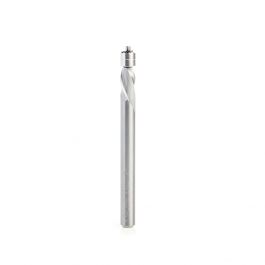Not cut any metal yet-- but i want to ! Thinking about rib making. At some point after I have turned down the outer edge to make the flanges, I will have to fluit.
The fluits go in between the rivet holes. (spaced evenly and centered im supposing-) So I would want to mark the rivet locations on the edge of the form blocks.
So how the heck- do i know where the skin rivet locations are ...... Also it should be very important -cosmetically- to have all the rows of rivet heads lined up in
nice straight lines after skinning. Once those holes are in the ribs I cant adjust them any short of making a new part. So it appears like a lot revolves arround
finding those hole locations accurately.
OK- may have answered my own question----- :-)
Just checked my drawing 3B (wing ribs) - I can see little tick marks representing rivet locations at the top and bottom of the ribs. So it seems like I should make like a
red sharpie mark on the form block at those locations. maybe make a green mark measured out the be exactly between the red marks. (fluit on green- dont touch red)
Then have to just figure the correct lengths for each rib by calculating the spar thickness at the different stations. Does that stack of sheets turn out any thicker than the sum
of the material thicknesses ? that is- does there need to be any slight fudge factor for the primer in the stack or the sheets being only 98% squeezed together ? Or-- is
that so small that no one notices or cares ? wouldnt think it would be more then .015 at worst.....
Am I missing anything major here before I start making my master rib model and the rib form blocks and then make a rib or two ?
Just got my new router table done. i have watched Mr. Snapp's good videos over and over. (thank you so much for those..... I appreciate your woodworkers viewpoint-
i am an ammatuer violinmaker- so everything you are doing seems straight ahead logical and precice ! )
Kind of getting excited to be getting close to making product finally !
Tim
The fluits go in between the rivet holes. (spaced evenly and centered im supposing-) So I would want to mark the rivet locations on the edge of the form blocks.
So how the heck- do i know where the skin rivet locations are ...... Also it should be very important -cosmetically- to have all the rows of rivet heads lined up in
nice straight lines after skinning. Once those holes are in the ribs I cant adjust them any short of making a new part. So it appears like a lot revolves arround
finding those hole locations accurately.
OK- may have answered my own question----- :-)
Just checked my drawing 3B (wing ribs) - I can see little tick marks representing rivet locations at the top and bottom of the ribs. So it seems like I should make like a
red sharpie mark on the form block at those locations. maybe make a green mark measured out the be exactly between the red marks. (fluit on green- dont touch red)
Then have to just figure the correct lengths for each rib by calculating the spar thickness at the different stations. Does that stack of sheets turn out any thicker than the sum
of the material thicknesses ? that is- does there need to be any slight fudge factor for the primer in the stack or the sheets being only 98% squeezed together ? Or-- is
that so small that no one notices or cares ? wouldnt think it would be more then .015 at worst.....
Am I missing anything major here before I start making my master rib model and the rib form blocks and then make a rib or two ?
Just got my new router table done. i have watched Mr. Snapp's good videos over and over. (thank you so much for those..... I appreciate your woodworkers viewpoint-
i am an ammatuer violinmaker- so everything you are doing seems straight ahead logical and precice ! )
Kind of getting excited to be getting close to making product finally !
Tim



Comment